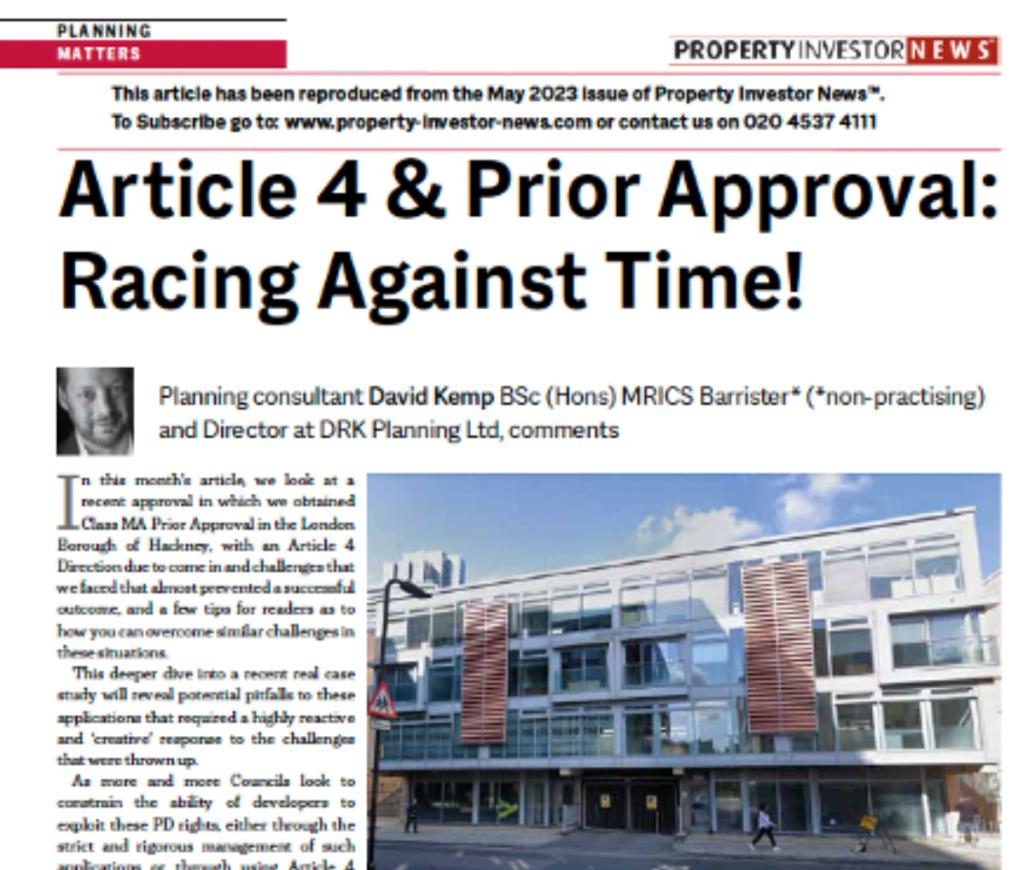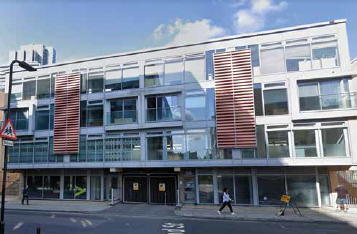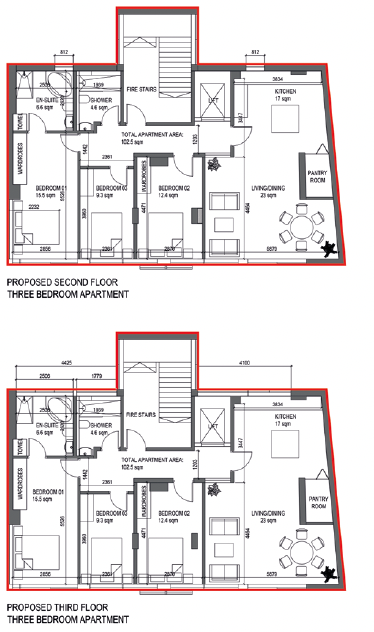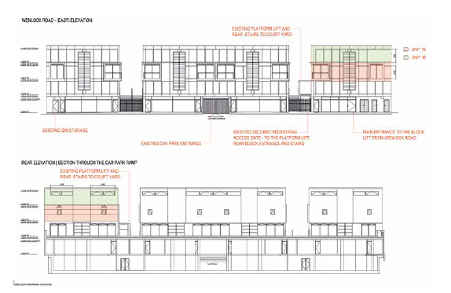
In this month’s article, we look at a recent approval in which we obtained Class MA Prior Approval in the London Borough of Hackney, with an Article 4 Direction due to come in and challenges that we faced that almost prevented a successful outcome, and a few tips for readers as to how you can overcome similar challenges in these situations.
This deeper dive into a recent real case study will reveal potential pitfalls to these applications that required a highly reactive and ‘creative’ response to the challenges that were thrown up.
As more and more Councils look to constrain the ability of developers to exploit these PD rights, either through the strict and rigorous management of such applications or through using Article 4 Directions, it is no longer about ‘ticking a few boxes’, throwing in an application and sitting back, folding your arms and ‘waiting for approval’. Clients and consultants need to be in regular and proactive communication throughout, pushing officers for responses and being ever mindful of the ‘ticking clock’, especially if an Article 4 Direction is expected to be confirmed soon that may withdraw PD rights from the site.
A Priority Office Area
The development site comprised two office suites to the upper floors of an existing office block in the City Fringe of Hackney, close to Angel Underground Station. The area has seen a growing mix of uses and dilution of traditional employment uses. This progressive loss of employment and office floor space has recently prompted the Council to seek to extend its current Article 4 powers, particularly over areas that have already been identified in the Local Plan as ‘Priority Office Areas’. This site is located in such an area (see street view below).

The City Fringe Article 4 Direction
Location: is the site within the area of the direction outlined in red (a map will accompany the Direction). Extent of affected uses: the Direction might not extend to all uses covered by some PD rights. Date confirmed/ immediate: for a Direction to come into force, it will have to carry two signatures – the date on which it is made and the date on which it is confirmed. The Council made this Article 4 Direction on 10th February 2022, but it was not due to come into effect until 11thFebruary 2023, when it was expected to be confirmed by the Secretary of State.
We had initially been instructed to prepare an application for planning permission in early 2022 for a change of use. At the time, and until 1st August 2022, this area was still covered by an Article 4 Direction that prevented the use of the former Class O prior approval rights, but this fell away without replacement on 1st August 2022 (GPDO, Schedule 2, Part 3, Class MA.1(1)(g)). We were aware that the Council had already made a new Article 4 Direction to cover this area in February 2022, but that it would not be confirmed for another 12 months. Therefore, we changed strategy to seek to exploit the window of opportunity for a prior approval application.
The ‘Red Line’ of the Application Site
As many local authority officers sometimes do not give feedback on the accuracy of plan drafting or compliance with the strict requirements of the GPDO until the ‘eleventh hour’ of many PD applications, it is important to be as precise and considered and complete in the approach to what is presented as possible. This was particularly important in this case given that we did not have the time to run multiple consecutive applications to address initial technical failings in the application material before February 2023.
In order to provide ‘valid’ prior approval applications, one should have regard to the following:
The legal requirements of the GPDO, and
Any Local Validation requirements
The legal requirements as to what must be presented with such applications are set out in the GPDO, Schedule 2, Part 3, Class V, Paragraph W: “a plan indicating the site and showing the proposed development”. Paragraph W also requires the supply of appropriately labelled floor plans and elevations. Strictly speaking, in prior approval applications, one need not provide any more than this. However, for more detail as to what needs to be shown in these plans and how they have to be highlighted, annotated and where the red line goes, further detail can be found in the ‘National Validation Requirements’.
The site/ block plan, floor plans and elevations below illustrate the way in which we had to identify the site on these plans, especially given that we were seeking consent only in respect of part of the building:
On the location plan, as the basement car park extended under other blocks besides the one where the subject offices were, a red line was placed around all buildings on this plan.
The floor plans, basement plan and elevations specifically and more precisely defined the limited access of the application.
Access points were labelled on the plans where relevant, car parking , cycle parking and bin storage locations identified.
Further information and explanation was provided in our Planning Statement.


Signing the Section 106 Agreement
As the application proceeded and we chased up progress with the Planning Department, we were then asked to enter into a Section 106 Agreement to ensure that future occupants would not be entitled to on-street car parking permits, except for ‘blue badge’ holders.
The two office suites had the benefit of at least one off-street car space between them in the basement. Local Plan policy allowed for the retention of this space if it was for a disabled user, and thus this was shown on the basement floor plan as such.
It soon became apparent that the need for a Section 106 Agreement was going to take the application past the proposed date for confirmation of the Article 4 Direction, in February 2023; a potential risk of refusal! The s106 deed was proposing an ‘ongoing obligation’ (I.e. maintaining a restriction on the use of parking) and thus the Council’s legal officers insisted that ALL the current owners of a legal interest in the land had to sign the deed – this included not only the current owner (who had a 999 years’ lease) but also the freeholder and the lender who owned a legal registered charge.
The officers would not accept that only the applicant sign, despite his 999 years’ lease. The only way around this would have been to pay a financial contribution to the Council instead, but legal officers would not accept this without further involvement with the Highways Officers (it would involve an amendment to the local highways traffic management orders). We did not have enough time for this.
Fortunately, we had a bit more time, as we were informed by the Council that the Article 4 Direction was not due to be confirmed until toward the end of April. This delay was much-needed due to the logistics of getting three different parties to sign the same s106 deed.
Running out of time to sign the Section 106 deed
It can sometimes be difficult to obtain the consent or cooperation of other parties to a legal deed to sign it, especially if they are not persuaded of the benefit to them or are concerned about the potential liability on them to be sued jointly with the applicant for breaches that they had no control over. Indemnities can be offered in return, but this is sometimes rebuffed and the applicant is left in stalemate, unable to progress the Section 106, without which prior approval will not be issued.
In order to overcome this situation, we suggested the use of a ‘Grampian-style’ planning condition that would allow the Section 106 to be signed at a later date but the prior approval to be issued now.
This type of condition takes its name from a legal case in which it was first approved by the courts. It is similar to a restrictive covenant in that it states that the applicant cannot do something until something else has happened first; e.g. “must not occupy the development unless a scheme for restricting the issue of residents’ parking permits to new occupiers of the development has first been agreed in writing with the local planning authority.”
Such an approach is not often used, and the National Planning Practice Guidance indicates that such approaches are usually the exception. Unsurprisingly, local authorities prefer to complete such s106 deeds before issuing a consent, not afterwards. However, given the imminent nature of the Article 4 Direction in this case, there was a reasonable justification for this approach and we managed to agree this with officers. It had also helped that we had agreed something similar on a different application in the London Borough of Richmond-on-Thames in similar circumstances fairly recently.
By agreeing through a planning condition to submit a Section 106 later this allows the applicant a lot longer to persuade the landlord to sign the deed, and ensures that at the very least the prior approval is granted before the Article 4 Direction takes effect.
The Article 4 Direction was confirmed with effect on the day after we received the consent. However, as we received the consent before the Article 4 Direction took effect (only just), the prior approval was lawful.It can sometimes be difficult to obtain the consent or cooperation of other parties to a legal deed to sign it, especially if they are not persuaded of the benefit to them or are concerned about the potential liability on them to be sued jointly with the applicant for breaches that they had no control over. Indemnities can be offered in return, but this is sometimes rebuffed and the applicant is left in stalemate, unable to progress the Section 106, without which prior approval will not be issued.
In order to overcome this situation, we suggested the use of a ‘Grampian-style’ planning condition that would allow the Section 106 to be signed at a later date but the prior approval to be issued now.
This type of condition takes its name from a legal case in which it was first approved by the courts. It is similar to a restrictive covenant in that it states that the applicant cannot do something until something else has happened first; e.g. “must not occupy the development unless a scheme for restricting the issue of residents’ parking permits to new occupiers of the development has first been agreed in writing with the local planning authority.”
Such an approach is not often used, and the National Planning Practice Guidance indicates that such approaches are usually the exception. Unsurprisingly, local authorities prefer to complete such s106 deeds before issuing a consent, not afterwards. However, given the imminent nature of the Article 4 Direction in this case, there was a reasonable justification for this approach and we managed to agree this with officers. It had also helped that we had agreed something similar on a different application in the London Borough of Richmond-on-Thames in similar circumstances fairly recently.
By agreeing through a planning condition to submit a Section 106 later this allows the applicant a lot longer to persuade the landlord to sign the deed, and ensures that at the very least the prior approval is granted before the Article 4 Direction takes effect.
The Article 4 Direction was confirmed with effect on the day after we received the consent. However, as we received the consent before the Article 4 Direction took effect (only just), the prior approval was lawful.
